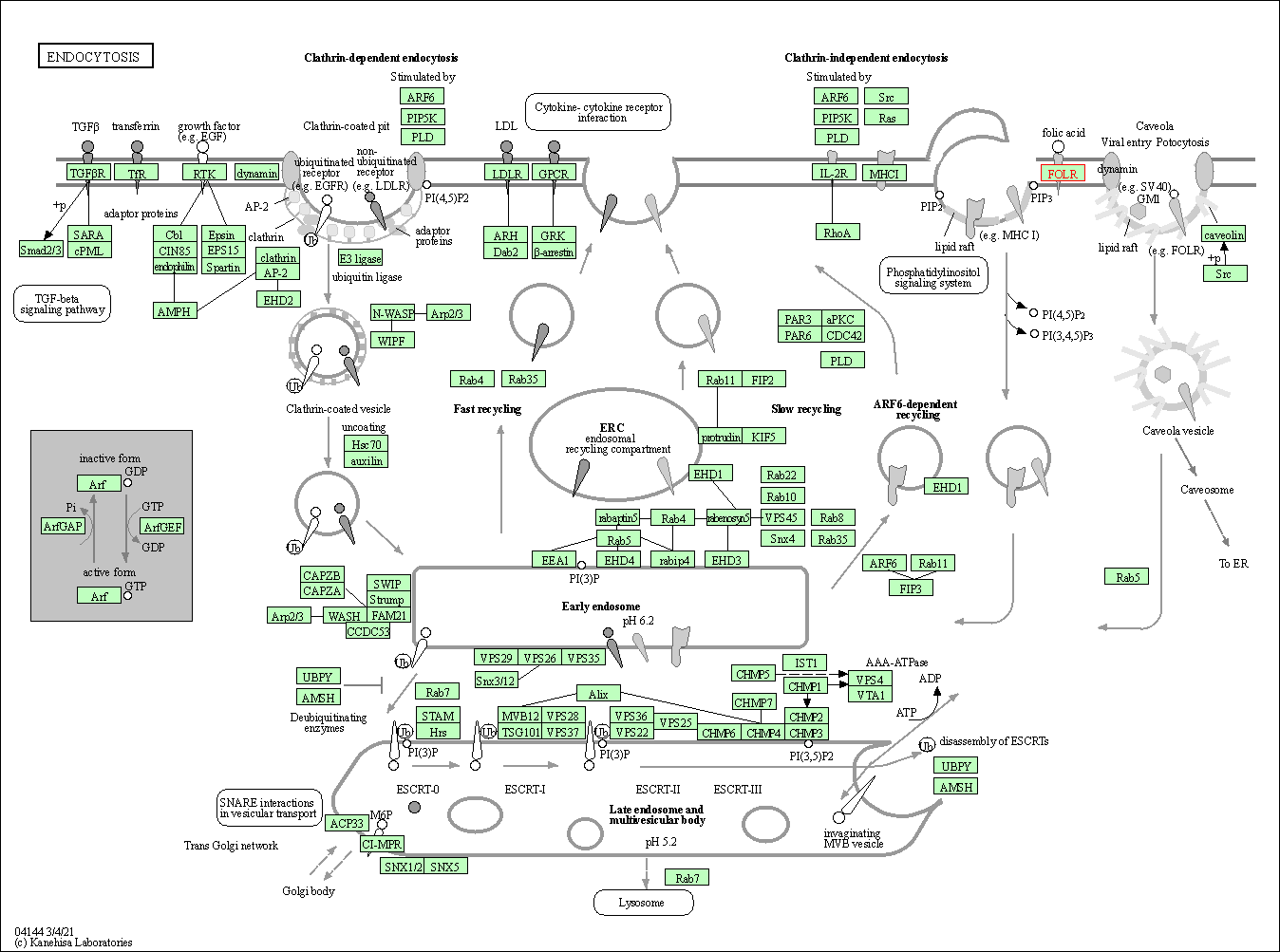Target Information
| Target General Information | Top | |||||
|---|---|---|---|---|---|---|
| Target ID |
T82297
(Former ID: TTDR00687)
|
|||||
| Target Name |
Folate receptor beta (FOLR2)
|
|||||
| Synonyms |
Placental folate-binding protein; Folate receptor, fetal/placental; Folate receptor type-beta; Folate receptor 2; FR-beta; FOLR2
Click to Show/Hide
|
|||||
| Gene Name |
FOLR2
|
|||||
| Target Type |
Literature-reported target
|
[1] | ||||
| Function |
Binds to folate and reduced folic acid derivatives and mediates delivery of 5-methyltetrahydrofolate and folate analogs into the interior of cells. Has high affinity for folate and folic acid analogs at neutral pH. Exposure to slightly acidic pH after receptor endocytosis triggers a conformation change that strongly reduces its affinity for folates and mediates their release.
Click to Show/Hide
|
|||||
| BioChemical Class |
Folate receptor
|
|||||
| UniProt ID | ||||||
| Sequence |
MVWKWMPLLLLLVCVATMCSAQDRTDLLNVCMDAKHHKTKPGPEDKLHDQCSPWKKNACC
TASTSQELHKDTSRLYNFNWDHCGKMEPACKRHFIQDTCLYECSPNLGPWIQQVNQSWRK ERFLDVPLCKEDCQRWWEDCHTSHTCKSNWHRGWDWTSGVNKCPAGALCRTFESYFPTPA ALCEGLWSHSYKVSNYSRGSGRCIQMWFDSAQGNPNEEVARFYAAAMHVNAGEMLHGTGG LLLSLALMLQLWLLG Click to Show/Hide
|
|||||
| 3D Structure | Click to Show 3D Structure of This Target | PDB | ||||
| HIT2.0 ID | T05SMP | |||||
| Cell-based Target Expression Variations | Top | |||||
|---|---|---|---|---|---|---|
| Cell-based Target Expression Variations | ||||||
| Drug Binding Sites of Target | Top | |||||
|---|---|---|---|---|---|---|
| Ligand Name: Methotrexate | Ligand Info | |||||
| Structure Description | Human folate receptor beta (FOLR2) in complex with the antifolate methotrexate | PDB:4KN0 | ||||
| Method | X-ray diffraction | Resolution | 2.10 Å | Mutation | No | [2] |
| PDB Sequence |
RTDLLNVCMD
33 AKHHKTKPGP43 EDKLHDQCSP53 WKKNACCTAS63 TSQELHKDTS73 RLYNFNWDHC 83 GKMEPACKRH93 FIQDTCLYEC103 SPNLGPWIQQ113 VNQSWRKERF123 LDVPLCKEDC 133 QRWWEDCHTS143 HTCKSNWHRG153 WDWTSGVNKC163 PAGALCRTFE173 SYFPTPAALC 183 EGLWSHSYKV193 SNYSRGSGRC203 IQMWFDSAQG213 NPNEEVARFY223 AAAMH |
|||||
|
|
||||||
| Ligand Name: Folic acid | Ligand Info | |||||
| Structure Description | Human folate receptor beta (FOLR2) in complex with the folate | PDB:4KMZ | ||||
| Method | X-ray diffraction | Resolution | 2.30 Å | Mutation | No | [2] |
| PDB Sequence |
TDLLNVCMDA
34 KHHKTKPGPE44 DKLHDQCSPW54 KKNACCTAST64 SQELHKDTSR74 LYNFNWDHCG 84 KMEPACKRHF94 IQDTCLYECS104 PNLGPWIQQV114 NQSWRKERFL124 DVPLCKEDCQ 134 RWWEDCHTSH144 TCKSNWHRGW154 DWTSGVNKCP164 AGALCRTFES174 YFPTPAALCE 184 GLWSHSYKVS194 NYSRGSGRCI204 QMWFDSAQGN214 PNEEVARFYA224 AAM |
|||||
|
|
||||||
| Click to View More Binding Site Information of This Target with Different Ligands | ||||||
| Different Human System Profiles of Target | Top |
|---|---|
|
Human Similarity Proteins
of target is determined by comparing the sequence similarity of all human proteins with the target based on BLAST. The similarity proteins for a target are defined as the proteins with E-value < 0.005 and outside the protein families of the target.
A target that has fewer human similarity proteins outside its family is commonly regarded to possess a greater capacity to avoid undesired interactions and thus increase the possibility of finding successful drugs
(Brief Bioinform, 21: 649-662, 2020).
Human Tissue Distribution
of target is determined from a proteomics study that quantified more than 12,000 genes across 32 normal human tissues. Tissue Specificity (TS) score was used to define the enrichment of target across tissues.
The distribution of targets among different tissues or organs need to be taken into consideration when assessing the target druggability, as it is generally accepted that the wider the target distribution, the greater the concern over potential adverse effects
(Nat Rev Drug Discov, 20: 64-81, 2021).
Human Pathway Affiliation
of target is determined by the life-essential pathways provided on KEGG database. The target-affiliated pathways were defined based on the following two criteria (a) the pathways of the studied target should be life-essential for both healthy individuals and patients, and (b) the studied target should occupy an upstream position in the pathways and therefore had the ability to regulate biological function.
Targets involved in a fewer pathways have greater likelihood to be successfully developed, while those associated with more human pathways increase the chance of undesirable interferences with other human processes
(Pharmacol Rev, 58: 259-279, 2006).
Human Similarity Proteins
Human Tissue Distribution
Human Pathway Affiliation
|
|
|
There is no similarity protein (E value < 0.005) for this target
|
|
Note:
If a protein has TS (tissue specficity) scores at least in one tissue >= 2.5, this protein is called tissue-enriched (including tissue-enriched-but-not-specific and tissue-specific). In the plots, the vertical lines are at thresholds 2.5 and 4.
|
| KEGG Pathway | Pathway ID | Affiliated Target | Pathway Map |
|---|---|---|---|
| Endocytosis | hsa04144 | Affiliated Target |

|
| Class: Cellular Processes => Transport and catabolism | Pathway Hierarchy | ||
| Chemical Structure based Activity Landscape of Target | Top |
|---|---|
| References | Top | |||||
|---|---|---|---|---|---|---|
| REF 1 | Strategy for the treatment of acute myelogenous leukemia based on folate receptor beta-targeted liposomal doxorubicin combined with receptor induct... Blood. 2002 Jul 15;100(2):594-602. | |||||
| REF 2 | Structures of human folate receptors reveal biological trafficking states and diversity in folate and antifolate recognition. Proc Natl Acad Sci U S A. 2013 Sep 17;110(38):15180-8. | |||||
If You Find Any Error in Data or Bug in Web Service, Please Kindly Report It to Dr. Zhou and Dr. Zhang.

